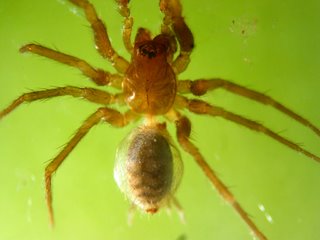Comb tailed spider | Hahnia mridulae
Hahnia mridulae Tikader, 1970 (FAMILY: HAHNIIDAE)
Common name: Comb tailed spider
Size: Female 3-4 mm, Male: unknown
Distribution: India.
Family Identification features: Small, three-clawed, eight-eyed spiders; tracheal spiracle open midway in abdomen instead of usual close to spinnerets; spinnerets situated in a transverse row; epigyne complex.
Family Descriptive features: Cephalothorax longer than wide; fovea short with striations; cephalic region narrowed. Generally light to dark brown with dark pattern, margined with black colour. Eight equal-sized eyes in two procurved rows. Sternum truncated anteriorly and pointed posteriorly. Labium wider than long. Chelicerae with two teeth on each side of fang furrow, lateral side of chelicerae with a seriesof ridges more strongly developed in males as stridulating organ for sound production. Legs short, robust, with three claws and a few setae. Abdomen oval, usually with a double row of oblique, pale markings on a grey background; general appearance often juvenile like. Six spinnerets in a single transverse row, posterior spinnerets long and two segmented; colulus present. Tracheal spiracle opens midway between the genital opening and the base of spinnerets. Epigyne flat, complex, entrance ducts usually strongly coiled. Tibial apophysis of male palp long and curved, patella usually with a basal hook, embolus thin, median apophysis reduced. A total of 4 species of 3 genera are reported from India so far.
Genus Identification features: Cephalothorax oval, longer than wide and narrowed in front; yellow, mottled with dark grey. Abdomen ovoid and slightly pointed posteriorly. It is overall grey with two elongated yellow areas along side the cardiac mark and with five transverse, chevronshaped yellow bands posteriorly. Legs short and yellow with grey annulations. Only one species is reported from India so far.
Species Identification features: Cephalothorax longer than wide, deep brown in colour, slightly narrowing in front; thoracic region flat with a dark fovea and radiating striae. Eyes pearly white, both rows straight, anterior medians smaller than others, posterior row slightly longer than anterior row and posterior medians larger than others. Ocular area provided with black patches. Sternum heart shaped and pointed behind. Labium wider than long. Legs stout, brownish green in colour, clothed with stiff hairs and a few spines. Abdomen oval shaped, clothed with fine hairs, light brown in colour, overlapping the posterior region of cephalothorax in front, mid dorsally with a row of inverted V shaped white cheverons and the remaining portion with white dots.
Natural History: Found in leaf litter and detritus or even on the leaves of shrubs and trees. These spiders spin delicate sheet webs near the soil surface. The spider hides beneath sand particles at the edge of the web. The stridulating organ is composed of a series of ridges on the lateral side of the chelicerae that are scraped against a spur on the palpal patella; stridulating organ strongly developed in males.
Contributed By : Sudhikumar A.V.
Common name: Comb tailed spider
Size: Female 3-4 mm, Male: unknown
Distribution: India.
Family Identification features: Small, three-clawed, eight-eyed spiders; tracheal spiracle open midway in abdomen instead of usual close to spinnerets; spinnerets situated in a transverse row; epigyne complex.
Family Descriptive features: Cephalothorax longer than wide; fovea short with striations; cephalic region narrowed. Generally light to dark brown with dark pattern, margined with black colour. Eight equal-sized eyes in two procurved rows. Sternum truncated anteriorly and pointed posteriorly. Labium wider than long. Chelicerae with two teeth on each side of fang furrow, lateral side of chelicerae with a seriesof ridges more strongly developed in males as stridulating organ for sound production. Legs short, robust, with three claws and a few setae. Abdomen oval, usually with a double row of oblique, pale markings on a grey background; general appearance often juvenile like. Six spinnerets in a single transverse row, posterior spinnerets long and two segmented; colulus present. Tracheal spiracle opens midway between the genital opening and the base of spinnerets. Epigyne flat, complex, entrance ducts usually strongly coiled. Tibial apophysis of male palp long and curved, patella usually with a basal hook, embolus thin, median apophysis reduced. A total of 4 species of 3 genera are reported from India so far.
Hahnia C. L. Koch, 1841
Genus Identification features: Cephalothorax oval, longer than wide and narrowed in front; yellow, mottled with dark grey. Abdomen ovoid and slightly pointed posteriorly. It is overall grey with two elongated yellow areas along side the cardiac mark and with five transverse, chevronshaped yellow bands posteriorly. Legs short and yellow with grey annulations. Only one species is reported from India so far.
Species Identification features: Cephalothorax longer than wide, deep brown in colour, slightly narrowing in front; thoracic region flat with a dark fovea and radiating striae. Eyes pearly white, both rows straight, anterior medians smaller than others, posterior row slightly longer than anterior row and posterior medians larger than others. Ocular area provided with black patches. Sternum heart shaped and pointed behind. Labium wider than long. Legs stout, brownish green in colour, clothed with stiff hairs and a few spines. Abdomen oval shaped, clothed with fine hairs, light brown in colour, overlapping the posterior region of cephalothorax in front, mid dorsally with a row of inverted V shaped white cheverons and the remaining portion with white dots.
Natural History: Found in leaf litter and detritus or even on the leaves of shrubs and trees. These spiders spin delicate sheet webs near the soil surface. The spider hides beneath sand particles at the edge of the web. The stridulating organ is composed of a series of ridges on the lateral side of the chelicerae that are scraped against a spur on the palpal patella; stridulating organ strongly developed in males.
Contributed By : Sudhikumar A.V.



0 Comments:
Post a Comment
<< Home